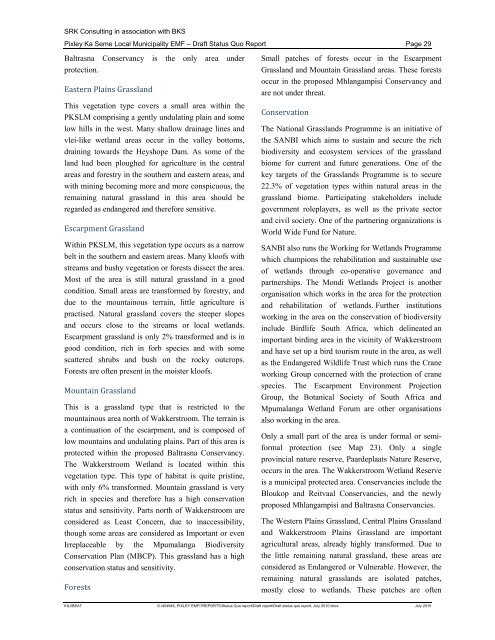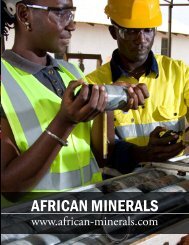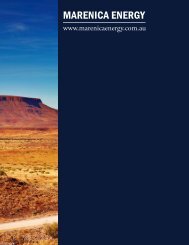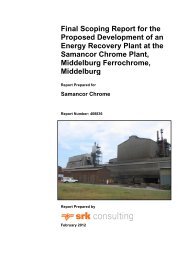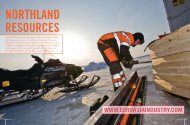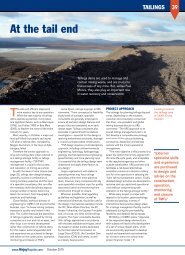Draft Status Quo Report for the Pixley Ka Seme ... - SRK Consulting
Draft Status Quo Report for the Pixley Ka Seme ... - SRK Consulting
Draft Status Quo Report for the Pixley Ka Seme ... - SRK Consulting
Create successful ePaper yourself
Turn your PDF publications into a flip-book with our unique Google optimized e-Paper software.
<strong>SRK</strong> <strong>Consulting</strong> in association with BKS<br />
<strong>Pixley</strong> <strong>Ka</strong> <strong>Seme</strong> Local Municipality EMF – <strong>Draft</strong> <strong>Status</strong> <strong>Quo</strong> <strong>Report</strong> Page 29<br />
Baltrasna Conservancy is <strong>the</strong> only area under<br />
protection.<br />
Eastern Plains Grassland<br />
This vegetation type covers a small area within <strong>the</strong><br />
PKSLM comprising a gently undulating plain and some<br />
low hills in <strong>the</strong> west. Many shallow drainage lines and<br />
vlei-like wetland areas occur in <strong>the</strong> valley bottoms,<br />
draining towards <strong>the</strong> Heyshope Dam. As some of <strong>the</strong><br />
land had been ploughed <strong>for</strong> agriculture in <strong>the</strong> central<br />
areas and <strong>for</strong>estry in <strong>the</strong> sou<strong>the</strong>rn and eastern areas, and<br />
with mining becoming more and more conspicuous, <strong>the</strong><br />
remaining natural grassland in this area should be<br />
regarded as endangered and <strong>the</strong>re<strong>for</strong>e sensitive.<br />
Escarpment Grassland<br />
Within PKSLM, this vegetation type occurs as a narrow<br />
belt in <strong>the</strong> sou<strong>the</strong>rn and eastern areas. Many kloofs with<br />
streams and bushy vegetation or <strong>for</strong>ests dissect <strong>the</strong> area.<br />
Most of <strong>the</strong> area is still natural grassland in a good<br />
condition. Small areas are trans<strong>for</strong>med by <strong>for</strong>estry, and<br />
due to <strong>the</strong> mountainous terrain, little agriculture is<br />
practised. Natural grassland covers <strong>the</strong> steeper slopes<br />
and occurs close to <strong>the</strong> streams or local wetlands.<br />
Escarpment grassland is only 2% trans<strong>for</strong>med and is in<br />
good condition, rich in <strong>for</strong>b species and with some<br />
scattered shrubs and bush on <strong>the</strong> rocky outcrops.<br />
Forests are often present in <strong>the</strong> moister kloofs.<br />
Mountain Grassland<br />
This is a grassland type that is restricted to <strong>the</strong><br />
mountainous area north of Wakkerstroom. The terrain is<br />
a continuation of <strong>the</strong> escarpment, and is composed of<br />
low mountains and undulating plains. Part of this area is<br />
protected within <strong>the</strong> proposed Baltrasna Conservancy.<br />
The Wakkerstroom Wetland is located within this<br />
vegetation type. This type of habitat is quite pristine,<br />
with only 6% trans<strong>for</strong>med. Mountain grassland is very<br />
rich in species and <strong>the</strong>re<strong>for</strong>e has a high conservation<br />
status and sensitivity. Parts north of Wakkerstroom are<br />
considered as Least Concern, due to inaccessibility,<br />
though some areas are considered as Important or even<br />
Irreplaceable by <strong>the</strong> Mpumalanga Biodiversity<br />
Conservation Plan (MBCP). This grassland has a high<br />
conservation status and sensitivity.<br />
Forests<br />
Small patches of <strong>for</strong>ests occur in <strong>the</strong> Escarpment<br />
Grassland and Mountain Grassland areas. These <strong>for</strong>ests<br />
occur in <strong>the</strong> proposed Mhlangampisi Conservancy and<br />
are not under threat.<br />
Conservation<br />
The National Grasslands Programme is an initiative of<br />
<strong>the</strong> SANBI which aims to sustain and secure <strong>the</strong> rich<br />
biodiversity and ecosystem services of <strong>the</strong> grassland<br />
biome <strong>for</strong> current and future generations. One of <strong>the</strong><br />
key targets of <strong>the</strong> Grasslands Programme is to secure<br />
22.3% of vegetation types within natural areas in <strong>the</strong><br />
grassland biome. Participating stakeholders include<br />
government roleplayers, as well as <strong>the</strong> private sector<br />
and civil society. One of <strong>the</strong> partnering organizations is<br />
World Wide Fund <strong>for</strong> Nature.<br />
SANBI also runs <strong>the</strong> Working <strong>for</strong> Wetlands Programme<br />
which champions <strong>the</strong> rehabilitation and sustainable use<br />
of wetlands through co-operative governance and<br />
partnerships. The Mondi Wetlands Project is ano<strong>the</strong>r<br />
organisation which works in <strong>the</strong> area <strong>for</strong> <strong>the</strong> protection<br />
and rehabilitation of wetlands. Fur<strong>the</strong>r institutions<br />
working in <strong>the</strong> area on <strong>the</strong> conservation of biodiversity<br />
include Birdlife South Africa, which delineated an<br />
important birding area in <strong>the</strong> vicinity of Wakkerstroom<br />
and have set up a bird tourism route in <strong>the</strong> area, as well<br />
as <strong>the</strong> Endangered Wildlife Trust which runs <strong>the</strong> Crane<br />
working Group concerned with <strong>the</strong> protection of crane<br />
species. The Escarpment Environment Projection<br />
Group, <strong>the</strong> Botanical Society of South Africa and<br />
Mpumalanga Wetland Forum are o<strong>the</strong>r organisations<br />
also working in <strong>the</strong> area.<br />
Only a small part of <strong>the</strong> area is under <strong>for</strong>mal or semi<strong>for</strong>mal<br />
protection (see Map 23). Only a single<br />
provincial nature reserve, Paardeplaats Nature Reserve,<br />
occurs in <strong>the</strong> area. The Wakkerstroom Wetland Reserve<br />
is a municipal protected area. Conservancies include <strong>the</strong><br />
Bloukop and Reitvaal Conservancies, and <strong>the</strong> newly<br />
proposed Mhlangampisi and Baltrasna Conservancies.<br />
The Western Plains Grassland, Central Plains Grassland<br />
and Wakkerstroom Plains Grassland are important<br />
agricultural areas, already highly trans<strong>for</strong>med. Due to<br />
<strong>the</strong> little remaining natural grassland, <strong>the</strong>se areas are<br />
considered as Endangered or Vulnerable. However, <strong>the</strong><br />
remaining natural grasslands are isolated patches,<br />
mostly close to wetlands. These patches are often<br />
KILI/BEAT G:\404946_PIXLEY EMF\7REPORTS\<strong>Status</strong> <strong>Quo</strong> report\<strong>Draft</strong> report\<strong>Draft</strong> status quo report, July 2010.docx July 2010


